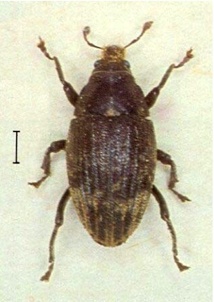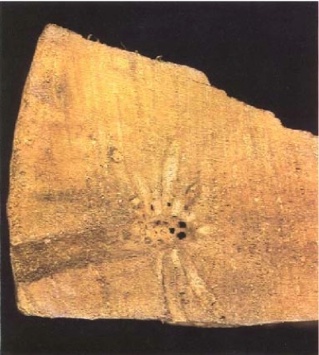PESTS AND DISEASES OF FORESTRY IN NEW ZEALAND
Pit weevils
Scion is the leading provider of forest-related knowledge in New Zealand
Formerly known as the Forest Research Institute, Scion has been a leader in research relating to forest health for over 50 years. The Rotorua-based Crown Research Institute continues to provide science that will protect all forests from damage caused by insect pests, pathogens and weeds. The information presented below arises from these research activities.
Forest and Timber Insects in New Zealand No. 5: Pit weevils.
Revised 2009
Based on J. Bain (1976)
Insect: Psepholax species (Coleoptera: Curculionidae)

Fig. 1 - Pit weevil. Line shows natural length.
Type of injury
The common name, pit weevil, is derived from the short tunnels, or pits, made by the adult females in the surface of the attacked material. The pits are circular in cross-section and are clear of bore dust. Their size varies according to the species of Psepholax involved, but is commonly 10-25 mm deep and 3-4 mm in diameter. The larval galleries, which are round in cross- section, penetrate deeply into the sapwood and are packed with a mixture of pellets and wood scrapings.

Fig. 2 - Larval tunnels radiating from bottom of pit made by the weevil.
Hosts
A wide range of indigenous and exotic softwoods is successfully attacked.
Distribution
These weevils are native to New Zealand and occur throughout the country.
Economic importance
These insects degrade slow-seasoning forest produce such as posts and poles, especially when these are stockpiled in the forest over the summer months. Pits may be excavated in treated posts and battens when they are stored in damp conditions but the damage does not extend further. The female weevil when excavating a pit does not swallow the wood but merely pushes it out behind her and is not poisoned by the salts impregnated in the wood during treatment. When the eggs hatch, the larvae eat the wood and are killed.
Description, life history, and habits
The adults can be up to 10 mm in length, the most commonly encountered species being 7-8 mm long. They are generally reddish-brown to black and somewhat barrel-shaped (Fig. 1). The short, broad snout has lateral grooves to accommodate the distinctly elbowed antennae. The elytra (wing cases) bear longitudinal ridges with various arrangements of hairs, scales, and bristles. The larvae are white, legless, G-shaped grubs with yellowish-brown heads.
Attack by pit weevils is usually confined to dead material, especially stumps and logs, in shaded or damp conditions. The female weevil excavates the pit to a depth of about 10-25 mm and lays her eggs in individual notches at the bottom. Initially the larval tunnels radiate out from the bottom of the pit (Fig. 2) but as the larvae grow the tunnelling pattern becomes confused. The length of the life cycle is not known for certain. It is possible that some of the smaller species could complete it in 1 year but most species would require two, or perhaps even three years.
Abortive attack on living eucalypts and Nothofagus spp. is not uncommon, and can result in serious timber defects, e.g., gum rings in Eucalyptus delegatensis and gum streaks in Nothofagus menziesii (silver beech). Freshly sawn timber of any host species may also be attacked, especially if it is stored under damp conditions.
Control
Generally speaking, no control measures are necessary providing forest produce is stored under well-ventilated conditions, but dipping or spraying with a contact insecticide should give protection in areas where there are heavy flights of the weevils.
Bibliography
Bain, J. 1976: Psepholax species (Coleoptera: Curculionidae). Pit weevils. New Zealand Forest Service, Forest and Timber Insects in New Zealand No. 5.
Hudson, G.V. 1934: New Zealand Beetles and their Larvae. Ferguson and Osborn, Wellington. 236 p.
Miller, D. 1971: Common Insects in New Zealand. A.H. and A.W. Reed, Auckland. 178 p.
This information is intended for general interest only. It is not intended to be a substitute for specific specialist advice on any matter and should not be relied on for that purpose. Scion will not be liable for any direct, indirect, incidental, special, consequential or exemplary damages, loss of profits, or any other intangible losses that result from using the information provided on this site.
(Scion is the trading name of the New Zealand Forest Research Institute Limited.)

 Farm Forestry New Zealand
Farm Forestry New Zealand

